This Vegan Traditional Creamy Stroganoff is a tasty, easy veggie adaptation of a classic beef stroganoff. This is also a mushroom-free stroganoff and we use textured vegetable protein (TVP) to replace the meat. Interestingly, the earliest stroganoff recipes didn't include mushrooms either. This easy to prepare meat-free stroganoff is savoury, creamy, and tangy and is delicious served with thick noodles, rice, or mashed potatoes. A wedge of crusty bread to mop up the delicious creamy juices is also a great addition.
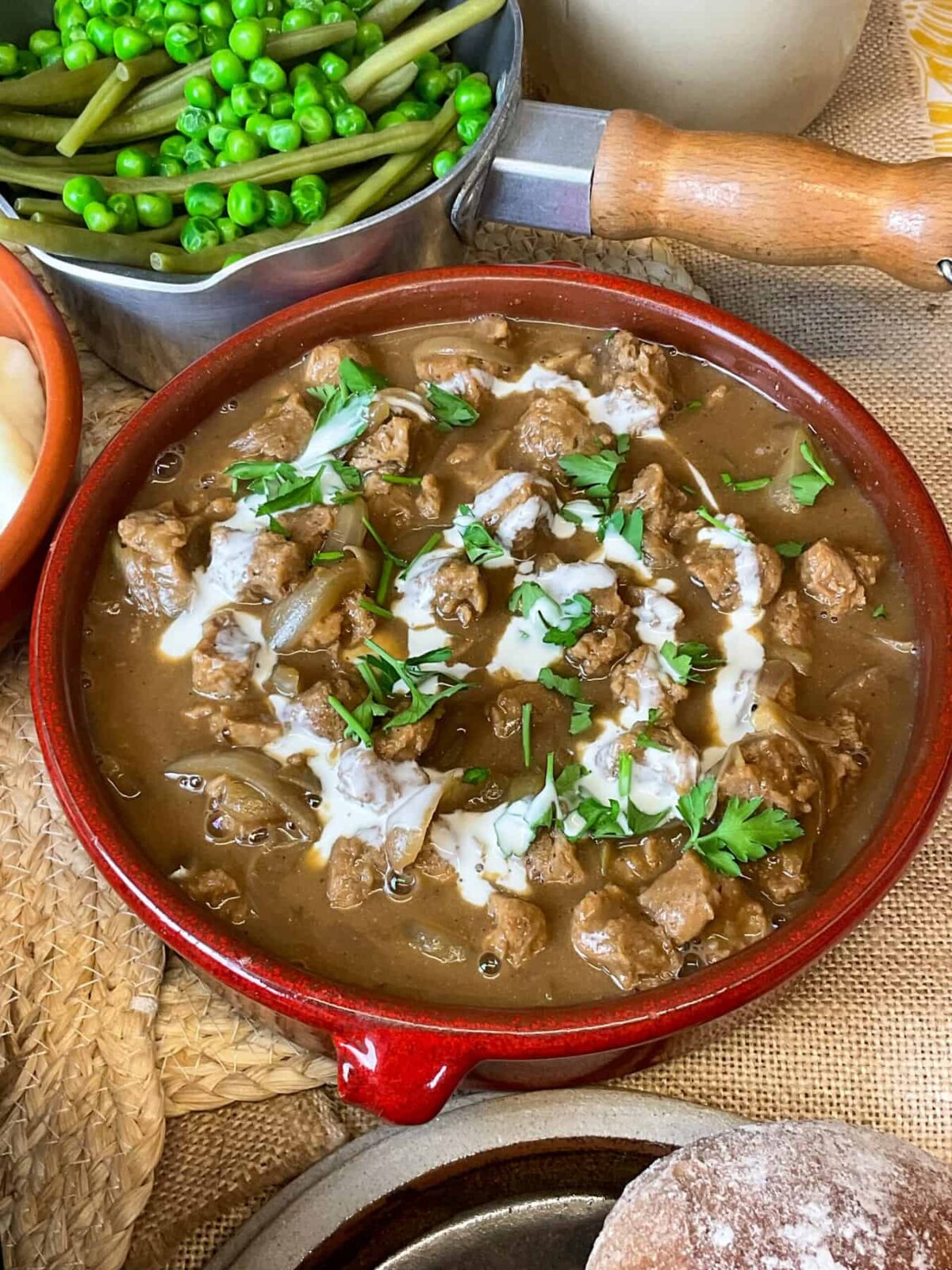
While this Vegan Stroganoff recipe doesn't include mushrooms, you can easily add a few cups of them if desired. Alternatively, if you're not fond of TVP, feel free to replace it with all mushrooms, or any meat-free pieces, or potatoes, or cubes of butternut squash, or a few cans of cooked beans - for delicious variations.
Origins of stroganoff
Stroganoff in essence is an old Russian dish of beef dish cooked in a creamy sauce along with onions and mushrooms - although the mushrooms are a more recent addition. The stroganoff creaminess comes from the addition of sour cream.
Beef Stroganoff, or Stroganov, has its origins in the 19th century. The dish is named after the Stroganov family, an influential and wealthy Russian family that was prominent during the Tsarist era. Although the exact origin of the recipe is unclear, it is believed to be traditionally based on a peasant meal, and there are a few theories about how it came to be associated with the Stroganov family.
One theory suggests that the dish was created by a French chef Andre Dupont who worked for the Stroganov family. This chef may have been inspired by traditional Russian and French cooking techniques, as Beef Stroganoff combines elements of both cooking traditions. For example, it features sautéed beef and onions, which are common ingredients in Russian cuisine while at the same time, it incorporates a creamy sauce, a popular element in French cookery. Crispy fried potatoes sliced into thin shapes 'potato straws', was a popular accompaniment to beef stroganoff.
Another theory is that the dish originated from a popular Russian recipe called "govjadina po-strogonovski", which was essentially sautéed beef served with a sour cream sauce. Over time, stroganoff recipes likely were adapted by various cooks and cuisines with the result being the modern Beef Stroganoff we know today which usually contains mushrooms.
Throughout the ages, Stroganoff became popular outwith Russia particularly in the United States during the mid-20th century, where mushrooms were a common addition, and the stroganoff was often served over rice or noodles.
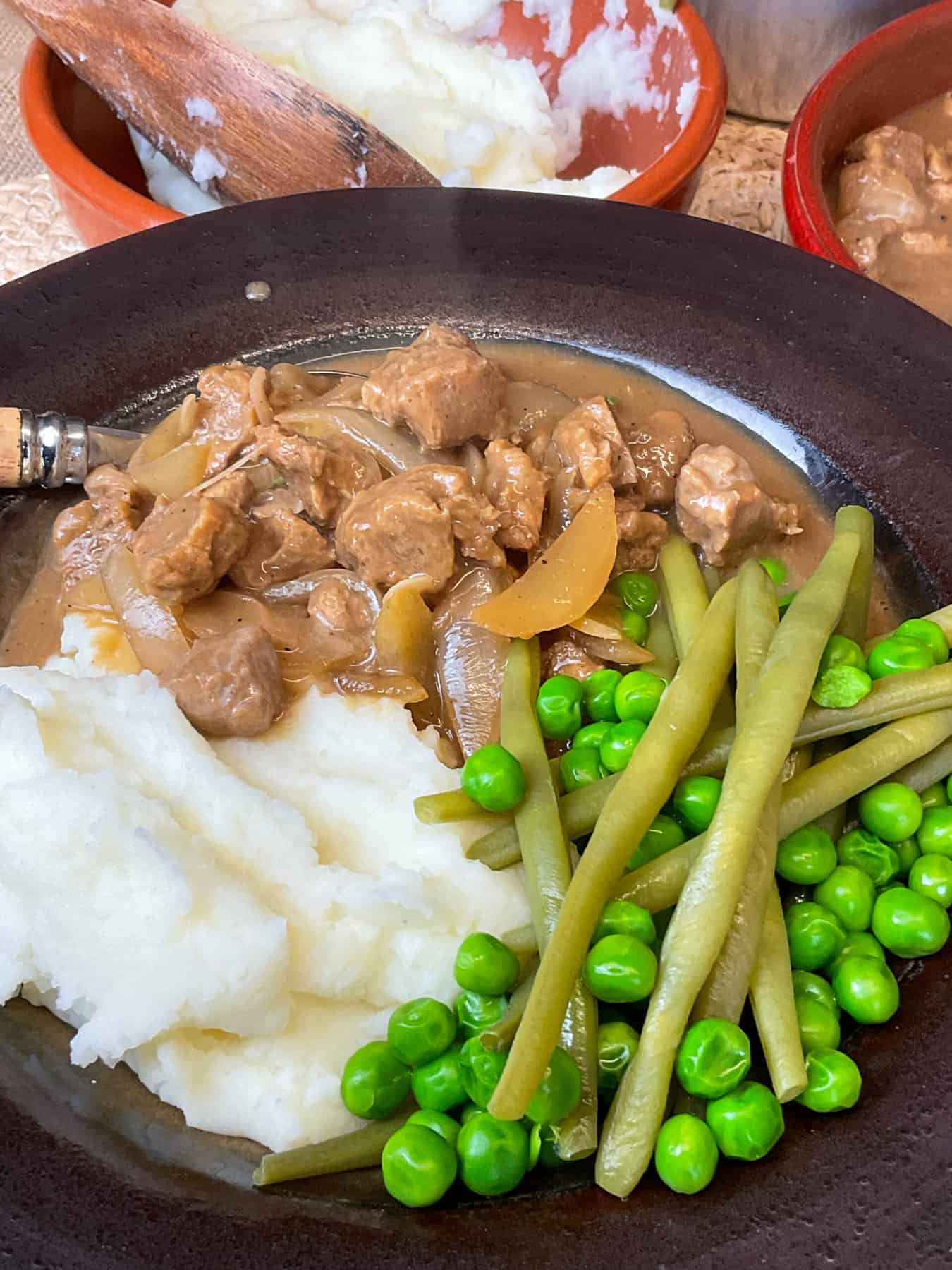
We have quite a few vegan TVP recipes on our blog as we find TVP very budget-friendly, easy to store, and when properly prepared the chunks soak up beautifully all the delicious flavours that you add. However, for most recipes the TVP chunks can be replaced with an alternative such as seitan, soy curls, meat-free pieces, cooked beans, tofu, or even potatoes or a vegetable such as butternut squash, sweet potatoes, or swede [turnip].
Stroganoff in the UK and US
Stroganoff started gaining popularity in the United States and the United Kingdom in the mid-20th century. The exact timeline varies, but it's generally agreed that stroganoff became more widely known after World War II.
In the United States, the popularity of Stroganoff surged during the 1950s and 1960s, when it became a fashionable dish to serve at dinner parties. It was often made with convenience foods like canned mushroom soup and packaged onion soup mix, which were common ingredients during this time.
In the United Kingdom, the dish similarly gained traction in the post-war period. It was featured in popular cookbooks, and the availability of international ingredients made it easier for home cooks to prepare Stroganoff.
While Stroganoff may not be as trendy today as it once was, it still is a favourite comfort food with many variations and adaptations to suit different tastes and dietary preferences.
Meat-Free Stroganoff
This recipe for vegan Stroganoff replaces the beef with textured vegetable protein (TVP) chunks, which are a one-ingredient vegan meat replacement made from defatted soy flour.
Of course, you can substitute the TVP chunks with an alternative such as fresh or frozen vegan 'beef' style pieces, or mushrooms, tofu, seitan, or cooked baby/new potatoes. To provide the sauce with its rich and deep savoury flavours, we add soy sauce, red wine vinegar, Marmite, and vegan 'beef' flavoured stock.
For the creaminess, the Stroganoff sauce includes vegan crème fraiche, but you can also use vegan plain yogurt, vegan sour cream, or vegan mayonnaise, depending on your preference and availability. Alternatively, we have often prepared a quick make-shift vegan sour cream by adding a squeeze of lemon juice to vegan cream.
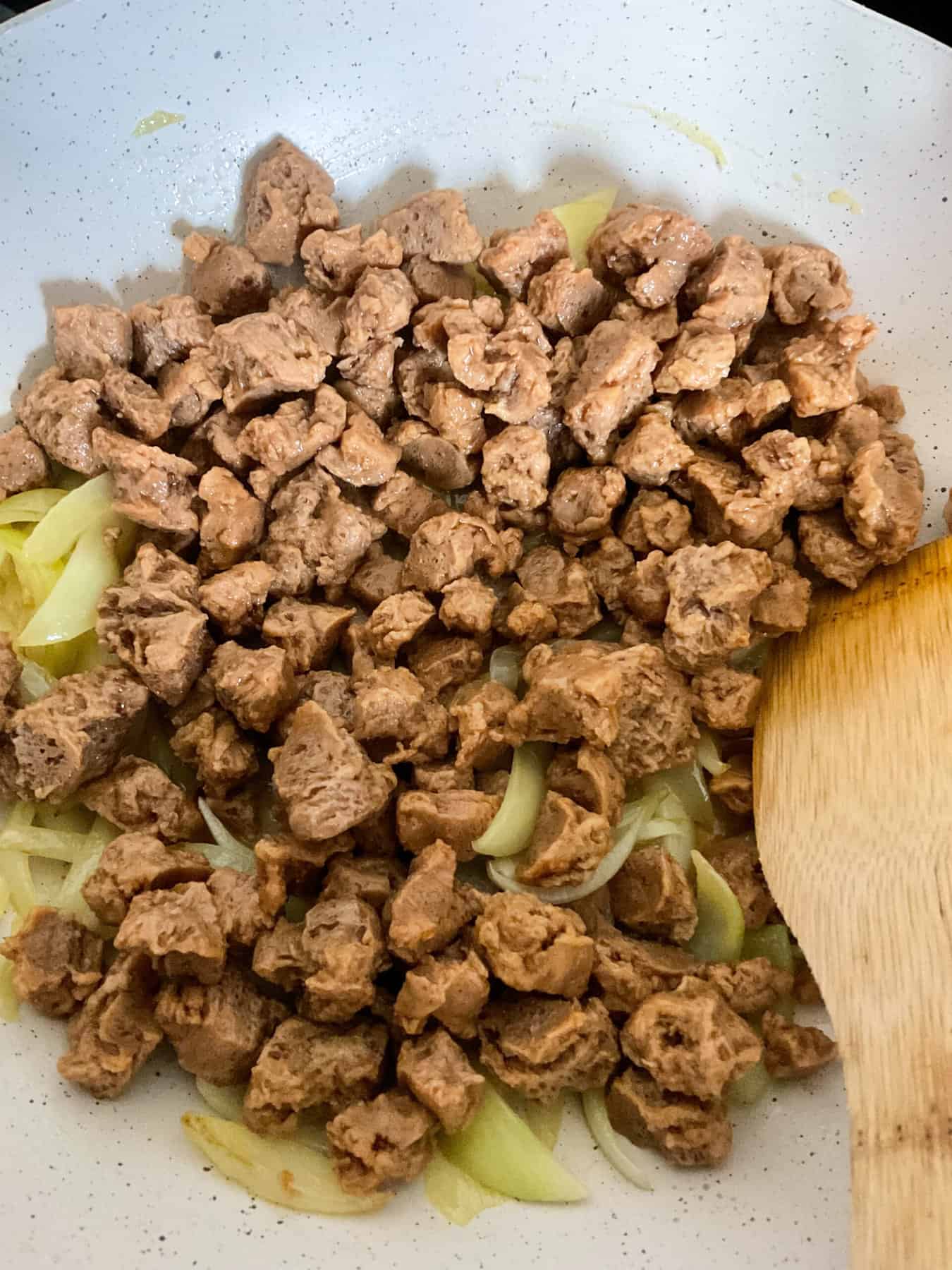
Textured vegetable protein (TVP) chunks are ideal for absorbing delicious savoury flavours. The secret to great-tasting TVP is marinating it in a nice vegetable stock for a few hours before use. If you're new to TVP, do have a look at our Thai 'beef' Curry recipe post which contains more information on TVP, as well as another delicious meat-free recipe to use up your bag of TVP.
How to prepare
You may have been put off making a stroganoff especially if you think you need to add mushrooms but interestingly, the earliest traditional Stroganoff recipes did not actually contain mushrooms.
However, if you like mushrooms then do feel free to add a cup of sliced mushrooms while cooking the onions.
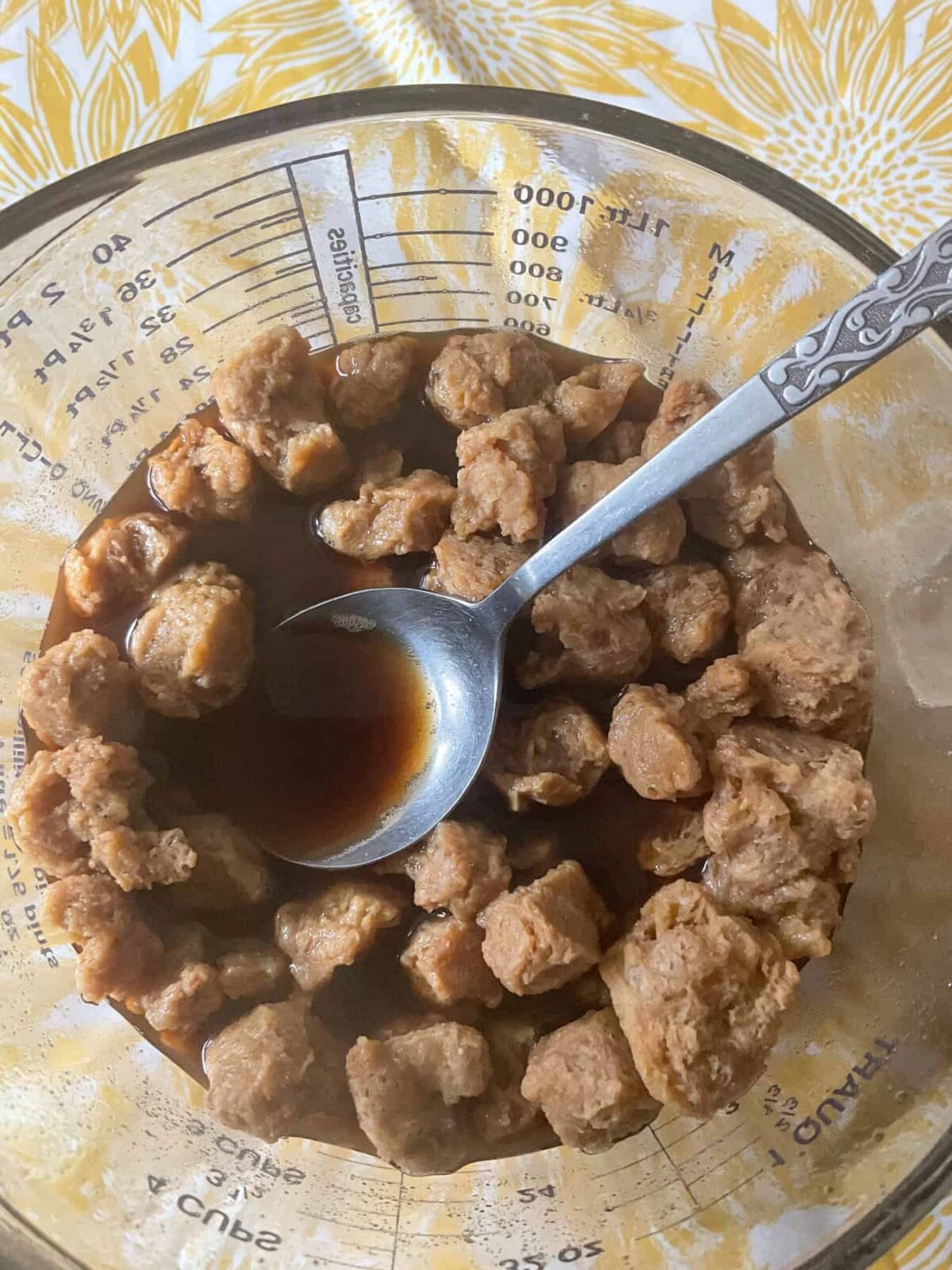
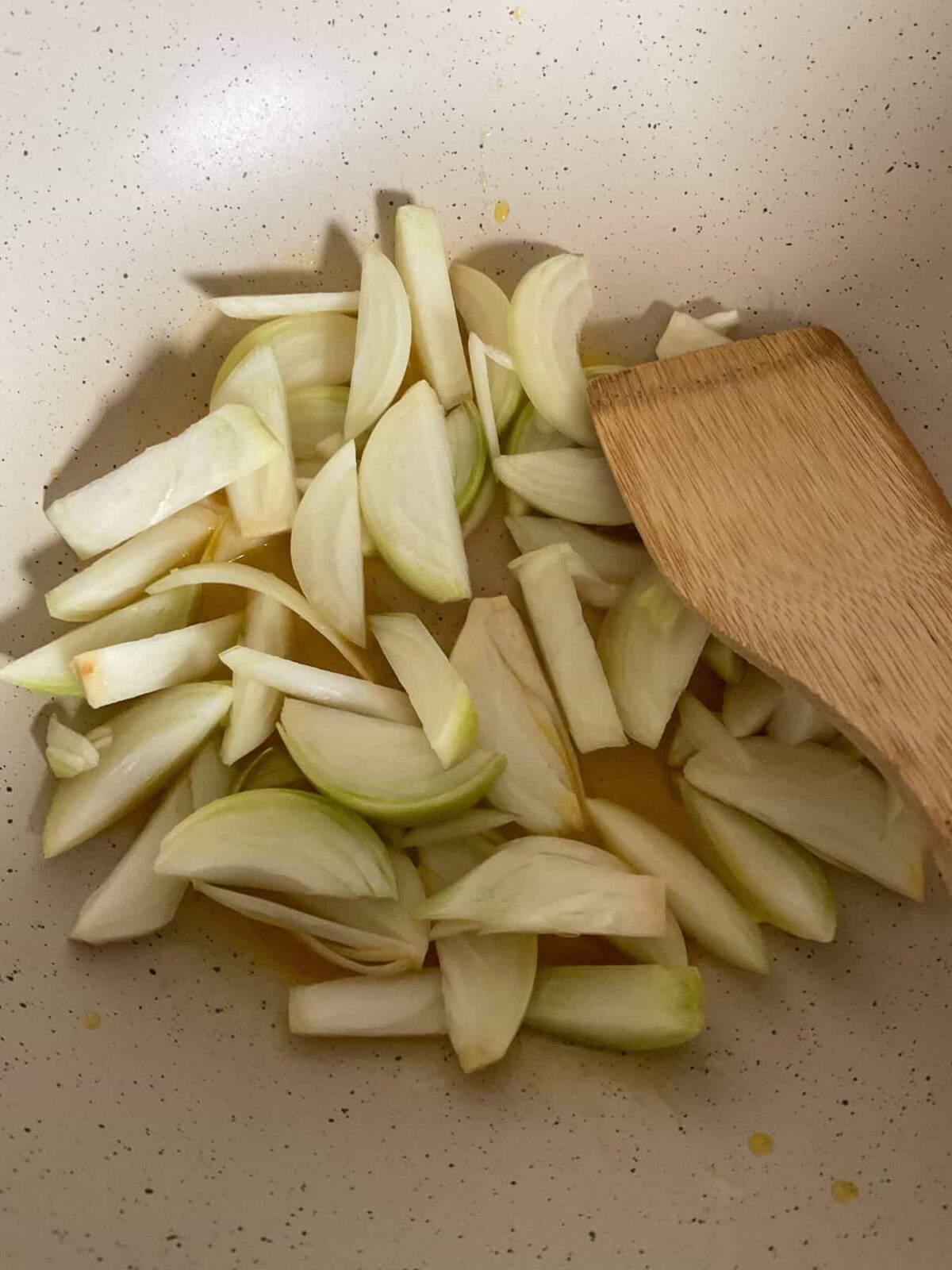
Step 1: First, add the dried TVP chunks to a heatproof jug and pour in 720ml (3 cups) of boiling hot vegetable stock. Stir in a teaspoon of Marmite or yeast extract.
Step 2: Cook the onions over a low-medium heat for 8-10 minutes until they are softened.
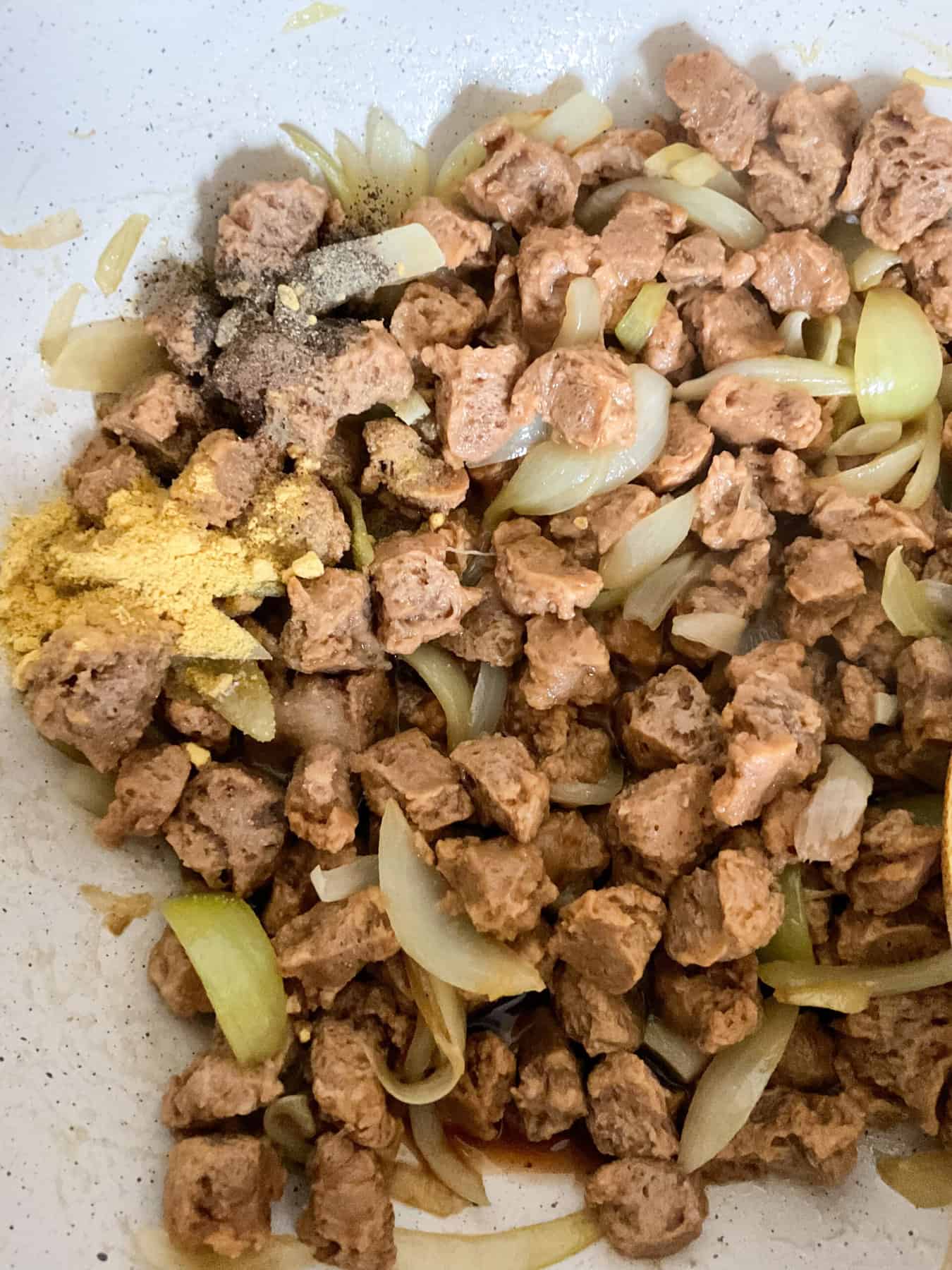
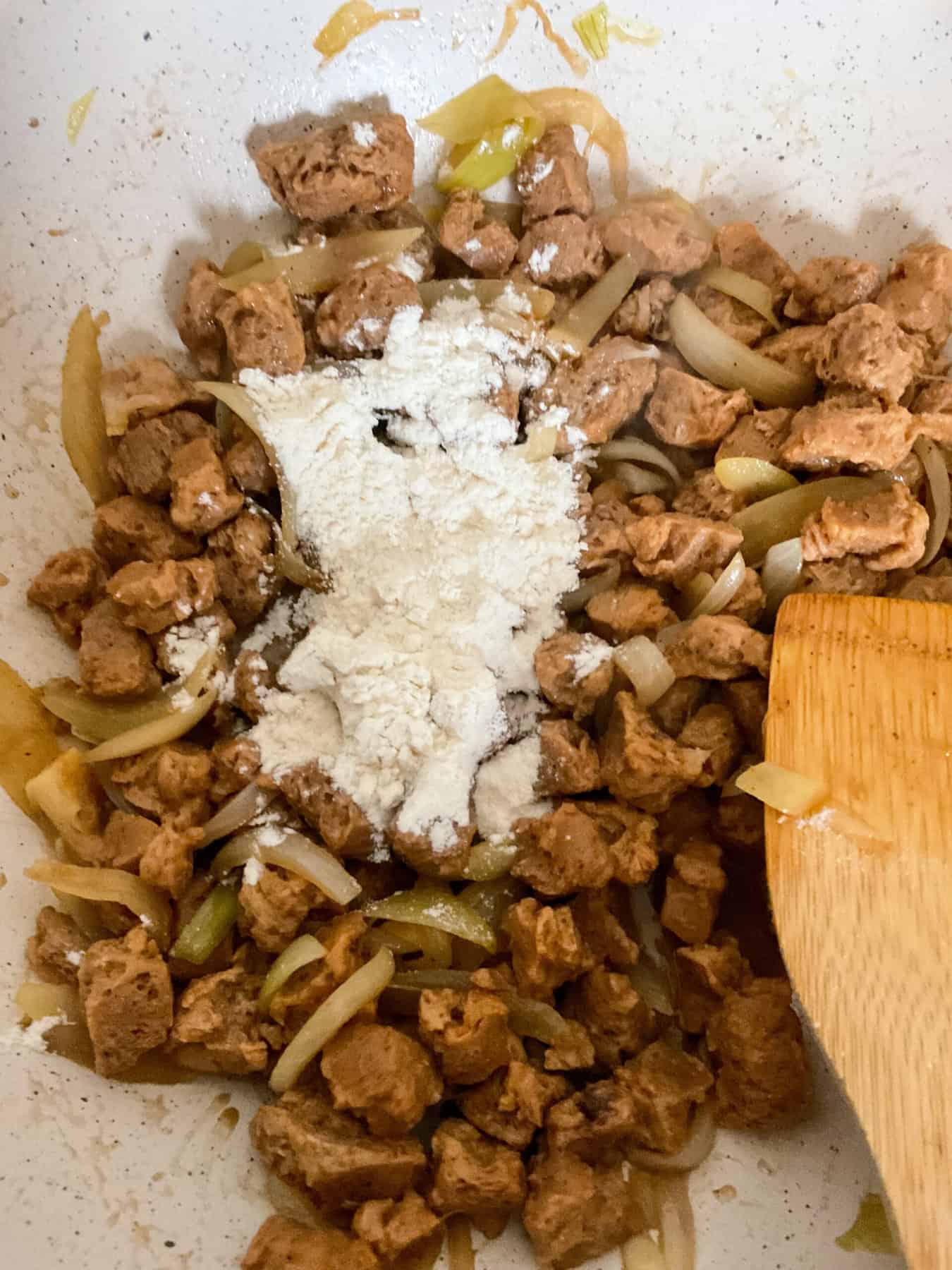
Step 3: Next, add the mustard powder, allspice powder [or nutmeg], soy sauce, red wine vinegar, salt, and pepper to the skillet.
Step 4: Add the flour and stir well.

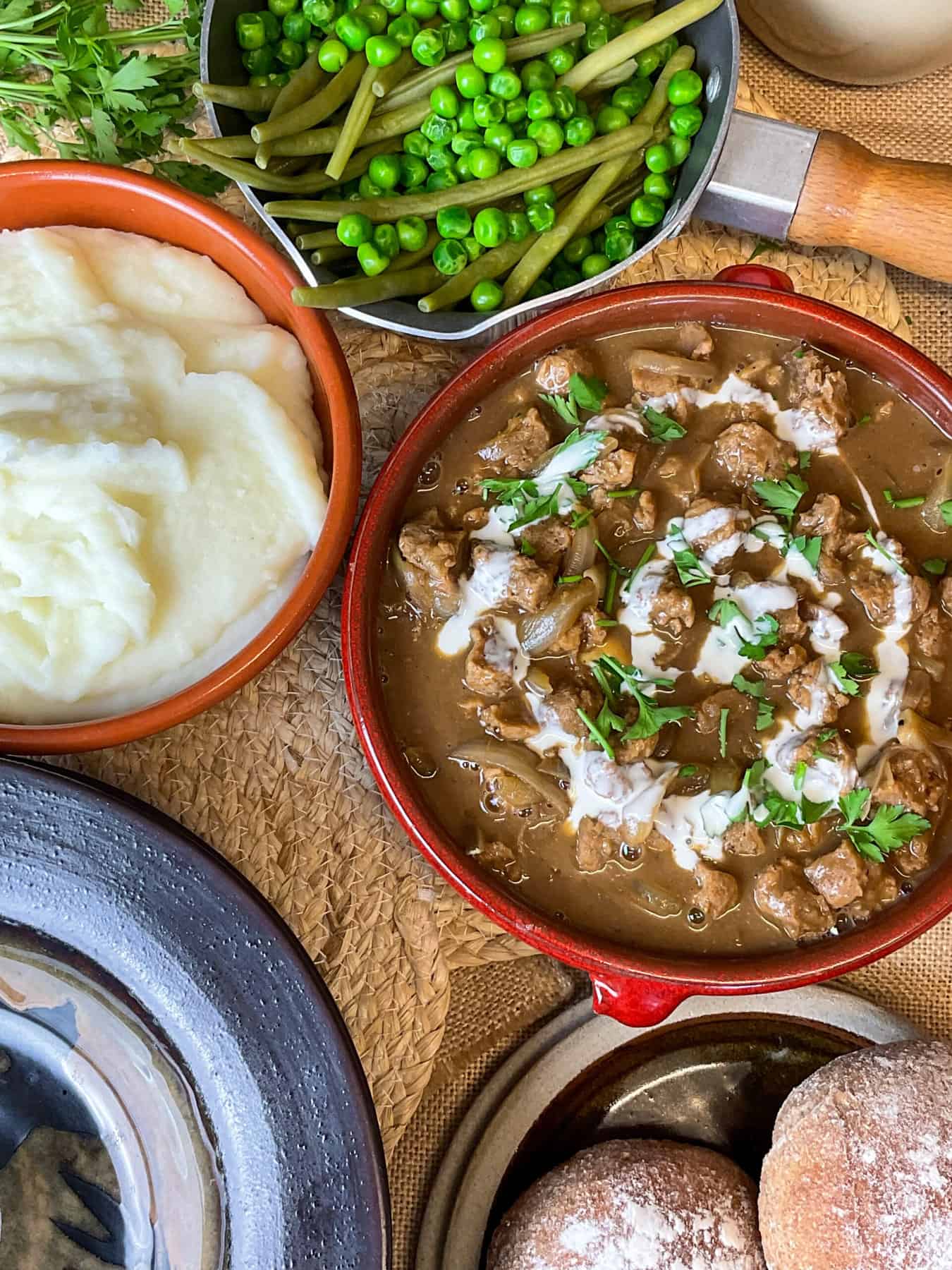
Step 5: Pour 450 millilitre's (2 ¾ US cups) of stock into the pan.
Step 6: Bring the mixture to a gentle boil, then reduce the heat and simmer for 15-20 minutes until the gravy has thickened.
Step 7: Remove the pan from the heat and check the seasoning, adding salt and pepper to taste.
Step 8: Stir in the vegan sour cream and garnish with freshly chopped parsley, if liked.
Serving suggestion: Enjoy with creamy mashed potatoes, thick noodles or pasta, rice, and your favourite green veggies. Slices of crusty bread are also a nice idea for mopping up the delicious gravy.
Recipe notes
Storing
Store leftovers within a covered container in the refrigerator for up to 3 days.
Reheating
Add leftovers to a non-stick pan and over a low heat gently reheat, stirring frequently until piping hot. Or reheat in a microwave-safe dish in the microwave, stirring every 30-60 seconds to ensure even heating. Stir through a little water, vegetable stock, or dairy-free milk if the sauce appears too thick but it will loosen up as it is heated.
FAQ'S
Surprisingly, the first Stroganoff recipes such as Elena Molokovet's Stroganoff recipe from 1831 did not contain mushrooms or onions. Our vegan adaptation is based on Elena Molokhovet's recipe which can be found in her book "A Gift to Young Housewives" (1831), titled "Beef Stroganov with Mustard."
Molokhovet's recipe ingredients include 2 lbs tender beef, 10-15 allspice, ¼ lb butter, salt, pepper, 2 spoons of flour, 2 tablespoons sour cream, bouillon (broth), and 1 teaspoon mustard.
The addition of mushrooms, onions, and tomato paste or puree in some Stroganoff recipes were added over time as the recipe became more popular outside of Russia. For example, in Germany, Stroganoff is known as "Geschnetzeltes" or "Zürcher Eintopf'' and the German version usually consists of thinly sliced meat, often veal or pork, cooked with onions and mushrooms in a creamy sauce. It is commonly served with noodles, rice, or potatoes.
Yes, with a few changes it is easy to prepare a gluten-free vegan stroganoff. TVP chunks are usually prepared with one ingredient - defatted soya flour - so are naturally gluten-free but if you source flavoured TVP chunks make sure that they are gluten-free.
For the soy sauce you will need to replace it with a gluten-free version such as Tamari or replace it with coconut aminos, and for the vegetable broth be sure to choose a gluten-free option. Also, you will need to replace the plain flour with a gluten-free plain flour.
Finally, we use Marmite to flavour the TVP chunks as it provides a nice savoury meaty flavour, however, regular Marmite, Vegemite, or yeast extract is not gluten-free due to the use of barley or wheat in the production process. You might be able to find gluten-free versions at your local store or supermarket as Vegemite does have a gluten-free option.
Alternatively, you can substitute Marmite with white miso paste but make sure to check the ingredients for a gluten-free option. You could also replace the Marmite with a tablespoon of gluten-free soy sauce such as Tamari, or coconut liquid aminos, or a gluten-free vegan Worcester sauce.
Vegan Stroganoff can be served with a variety of delicious sides to complement its rich flavours. Here are a few ideas:
* Serve the Stroganoff over rice, pasta, thick noodles, quinoa, couscous or bulgur wheat.
* Creamy mashed potatoes either made from regular potatoes or sweet potatoes, pair really well with the Stroganoff sauce. Or go for a scoop or two of delicious Traditional British Champ [mashed potatoes, turnips and cabbage].
* Green beans, broccoli, asparagus, Brussels sprouts, or a medley of your favourite vegetables.
* A crisp green salad with a tangy vinaigrette or salad dressing.
* A warm slice of crusty bread or a dinner roll is perfect for mopping up the Stroganoff sauce. Try a slice of our traditional wholemeal Irish Soda Bread or a a wedge of this crusty white bread - Australian Damper Bread [both these breads are no-yeast, no-rise, and no-knead breads]. For a quick roll or bap try these easy 3 Ingredient Dinner Rolls which are more scone or dumpling like but are perfect for savoury stews, soups and casseroles.
* The tangy flavours of pickles such as pickled cabbage, onions, or beetroot, or sauerkraut go perfectly with the Stroganoff.
Leftover stroganoff is perfect for creating new meals, making it very worthwhile to prepare two batches at once to ensure the next day's dinner is sorted. Here are a few of our favourite ideas:
1. Stuffed Peppers: Hollow out bell peppers, fill them with the leftover Stroganoff, and bake until the peppers are tender. You can top the stuffed peppers with vegan cheese, nutritional yeast flakes, breadcrumbs etc, before baking for an extra layer of flavour.
2. Vegan Stroganoff Shepherd's Pie: Layer the leftover Stroganoff in a baking dish, top with a layer of creamy mashed potatoes (or sweet potatoes or mixed root vegetable mash), and bake until the top is golden and crispy. A sprinkle of nutritional yeast flakes or vegan cheese over the potatoes before the pie is baked is a tasty addition.
3. Stroganoff Pot Pie: Spoon the leftover Stroganoff into a pie dish and cover with a layer of puff pastry or shortcrust pastry. Bake until the crust is golden brown and the filling hot and bubbling. You can make one large pie or prepare small individual pies using ramekin or soufflé dishes.
4. Stroganoff-Stuffed Crepes or flatbreads: Prepare vegan crepes and fill them with the leftover Stroganoff. Fold the crepes and serve them with a crispy side salad and a dollop of vegan sour creme or plain yogurt.
5. Vegan Stroganoff Quesadillas: Spread the Stroganoff over half of a large tortilla, sprinkle with your favourite vegan cheese, and fold the tortilla in half. Cook the quesadilla in a non-stick pan over medium heat until the tortilla is golden and the cheese has melted.
6. Stroganoff-Stuffed Portobello Mushrooms: Remove the stems and gills from large Portobello mushroom caps, fill the caps with the leftover Stroganoff, perhaps topping with a sprinkle of shredded vegan cheese or nutritional yeast flakes and breadcrumbs, and bake until the mushrooms are juicy and tender.
7. Vegan Stroganoff Burritos: Fill a large tortilla with the leftover Stroganoff, along with some cooked rice and your choice of vegetables, green leafy veggies, or salad bits such as sliced tomatoes, cucumber, spring onions [green onions], red onion rings, etc. Wrap the tortilla into a burrito and serve with vegan sour cream, vegan mayonnaise or vegan plain yogurt, and perhaps a scoop of salsa or guacamole.
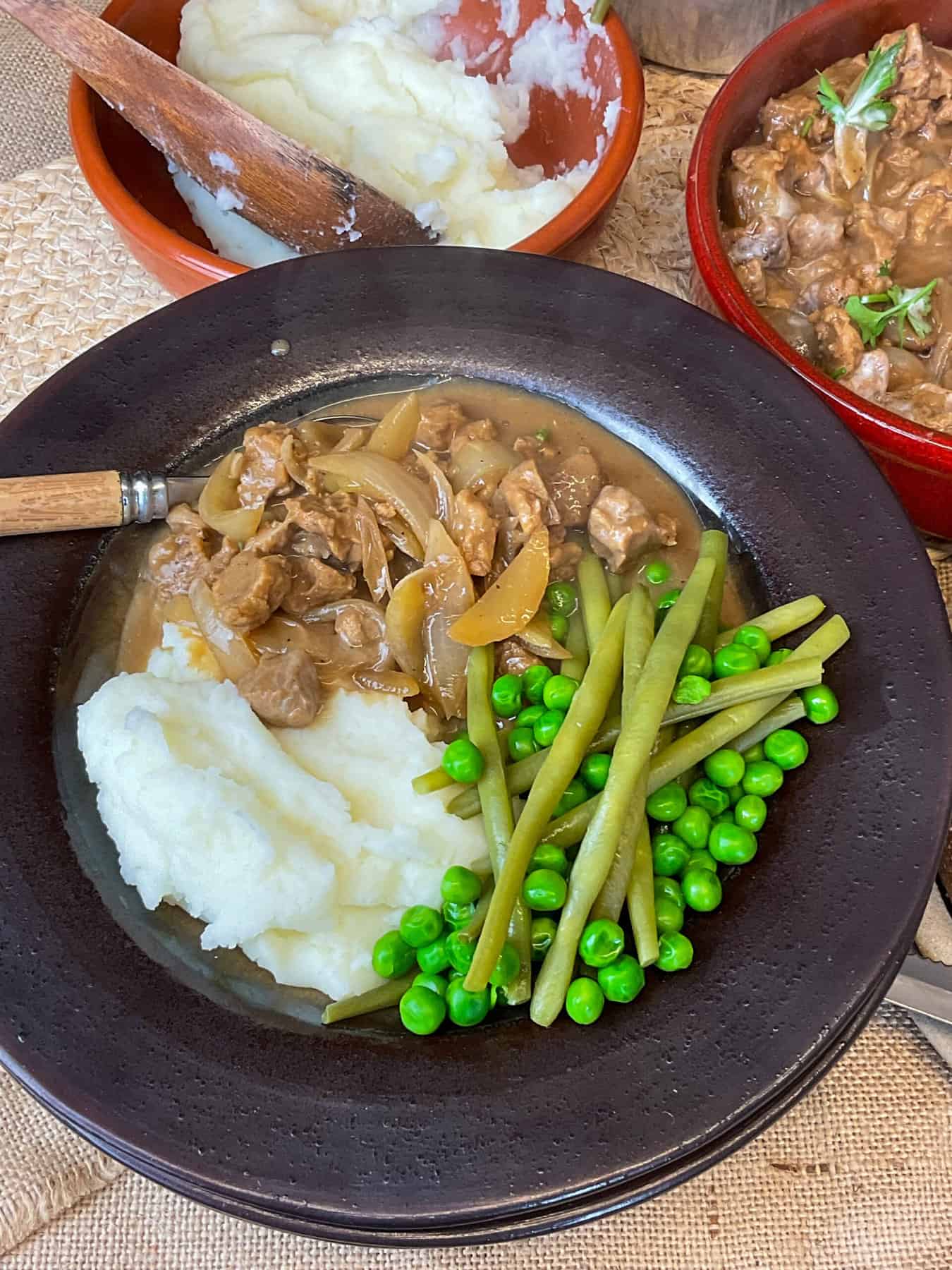
More vegan TVP recipes
Textured Vegetable Protein [TVP] comes in a variety of shapes but the most common are chunks and mince. We use TVP chunks to prepare this deliciously easy Vegan Thai Beef Curry in the slow cooker as well as this stove-top Vegan Beef and Tomato Stew which is a meat-free take on the classic British beef stew.
For a traditional homely pie our Vegan Meat and Potato Pie is perfect for family Sunday dinners and for mid-week meals our Vegan Scottish Mince & Tatties uses TVP mince and can be easily prepared in the slow cooker or stove-top.
***please note: for US measurements click the 'US customary button' within the recipe and the measurements will switch to tablespoons, cups, and ounces.***
📖 Recipe
Vegan Traditional Stroganoff
Equipment
- large non-stick pan or skillet
- heatproof jug or bowl
- mixing spoon
Ingredients
TVP chunks, prep:
- 120 grams textured vegetable protein chunks [TVP] [dried]
- 1 teaspoon marmite [or Vegemite or yeast extract extract, or replace with a few teaspoons of miso paste, soy sauce, liquid aminos, or vegan Worcester sauce]
- 720 millilitres vegetable stock [hot- if available use 1-2 vegan 'beef' flavour stock cube such as OXO meat free beef cubes or vegan bouillon paste to make up the stock]
Meat-free Stroganoff:
- 2 tablespoons vegan butter [or vegan margarine]
- 170 grams onion [1 large, chopped]
- 1 teaspoon mustard powder [such as Colemans]
- ¼ teaspoon black pepper
- ¼ teaspoon salt [we use sea salt]
- ⅙ teaspoon allspice powder [or replace with ground nutmeg]
- 1 tablespoon soy sauce
- 1 tablespoon red wine vinegar
- 2 tablespoons plain flour [all-purpose or use a gluten-free plain flour]
Add at the end of cooking:
- 3 tablespoons vegan sour cream [or vegan creme fraiche plain yogurt, or vegan cream with a squeeze of fresh lemon juice stirred through]
Optional garnish:
- chopped fresh parsley [or your choice of fresh herbs - chives are a nice addition]
Instructions
Prep the TVP chunks:
- Add the dried TVP chunks to a heatproof jug or bowl and pour in 720ml (3 cups) of hot vegetable stock. Stir in the Marmite until dissolved.Leave the chunks to soak for a few hours, stirring occasionally, if you're around.120 grams textured vegetable protein chunks [TVP], 1 teaspoon marmite, 720 millilitres vegetable stock
- Once the TVP chunks have finished soaking, drain the stock but be sure to reserve it for the recipe.If there is less than 450 milliliters (about 1.9 US cups) of stock remaining, add a little extra water to bring the total volume up to 450 milliliters for use in the recipe.
Prepare the stroganoff:
- Melt the vegan butter in a non-stick pan.2 tablespoons vegan butter
- Add the onions and cook them over low-medium heat for about 8 minutes until they become soft, stir the onions occasionally. It's fine if they turn slightly golden in colour.170 grams onion
- Next, add the mustard powder, allspice powder, soy sauce, red wine vinegar, salt and pepper to the pan. Stir well.1 teaspoon mustard powder, ¼ teaspoon black pepper, ¼ teaspoon salt, ⅙ teaspoon allspice powder, 1 tablespoon soy sauce, 1 tablespoon red wine vinegar
- Next, mix in the flour.2 tablespoons plain flour
- Pour the 450 milliliters (1.9 US cups) of reserved stock into the pan and mix well.Bring to a gentle boil, then reduce the heat and simmer for 20 minutes. The gravy will thicken up.
- Remove the pan from the heat and check the seasoning, adding salt and pepper to taste.Stir in the vegan sour cream and garnish with freshly chopped parsley, if liked.A swirl of extra cream is a nice addition on the top of each serving.3 tablespoons vegan sour cream, chopped fresh parsley
- Serving suggestion: Serve the Stroganoff alongside creamy mashed potatoes, thick noodles, or rice, and your favourite green vegetables.For those with larger appetites, add a crusty roll or slice of bread to soak up the tasty gravy.
Notes
- Nutritional information is for guidance only and is not a strict calculation as ingredients can vary.
- While this recipe uses textured vegetable protein (TVP) chunks, you can also use other vegan protein options such as tofu, tempeh, seitan, cooked beans such as butterbeans, kidney beans, or cannellini beans, or store-bought vegan meat-free pieces. Although be sure and rehydrate dried chunks such as soy curls before using with this recipe.
- Alternatively, instead of TVP you can use potatoes, turnip/swede, or butternut squash.
- This recipe is intentionally mushroom-free as the first stroganoff recipes did not contain mushrooms so it is ideal for those who dislike mushrooms. However, if you're a fan of mushrooms, feel free to add 1-2 cups of sliced mushrooms or whole button mushrooms while cooking the onions.
- To make this recipe gluten-free, use a gluten-free soy sauce such as tamari or coconut aminos, a gluten-free vegetable stock, and a gluten-free plain flour. Also, as Marmite is not gluten-free and if a gluten-free yeast extract can't be found replace it with gluten-free white miso paste, or a tablespoon of tamari soy sauce or coconut aminos, or a gluten-free vegan Worcester sauce.
- Leftovers can be stored for 3 days within a refrigerator or 2-3 months within the freezer.
- When reheating leftover stroganoff, you may need to add a splash of vegetable stock to thin out the sauce if it becomes too thick. Reheat until piping hot.
- This recipe suggests garnishing the stroganoff with fresh parsley, but you can also use fresh dill, chives, or even a sprinkle of nutritional yeast for added flavour.
- For this recipe, we used three OXO meat-free beef stock cubes to make the vegan stock to soak the TVP chunks. These stock cubes are available in most UK supermarkets and are not too strong in seasoning but they do add a nice savoury taste. For other types of stock cubes, bouillon cubes or paste, or stock powder you may require less of it to make up the stock especially if you know your stock is quite concentrated in flavour.
- If you enjoy a little heat in your dishes, feel free to add a pinch of red pepper flakes, chilli flakes, cayenne pepper, or a dash of hot sauce to taste.
- Can't find a vegan sour cream, creme fraiche, or plain yogurt? A squeeze of fresh lemon juice added to vegan cream is a good substitute. We tend to use Oatley oat cream or Alpro soya single cream [both are long life products].
Nutrition
Comments
Prepared our Vegan Traditional Stroganoff? We would love to know how you got on with the recipe so do drop us a comment below and click the star ratings. All feedback very much appreciated. Thanks so much, All the best Jacq x
Nick says
I'm all for people eating whatever they want but a "traditional" stroganoff contains meat. it's a vegan stew in the style of a stroganoff. I'm sure it's delicious !!
Jacq says
Thanks for the comment Nick! You are absolutely correct it is a delicious vegan stew in the style of a stroganoff but using the word 'traditional' just means that I was aiming to be close to the actual 19th century stroganoff, albeit minus the meat and dairy. My recipes are vegan adaptations of traditional, vintage, classic, retro, and historical favourites so using those words to describe a specific recipe reflects that idea. I think its only right that I highlight the country, culture, and recipe where our vegan adaptation has originated or evolved from. They are many reasons why people can not eat meat or animal products for example allergy reason, ethical reasons, moral reasons, health reasons, environmental reasons, financial or budget reasons, availability reasons, etc., but they love traditional recipes so having meat-free, vegan, and plant-based adaptations of those meals means they can continue to enjoy their favourite meals whilst also discovering new traditional recipes with some hopefully interesting food history thrown in! All recipes and traditional foods have evolved and been adapted throughout the centuries and vegan versions are just a progression of the recipes evolution and adaptation. Of course, if you do eat meat and dairy and you would like to make a traditional 19th Century stroganoff then you can find an old recipe in this book ''Classic Russian Cooking: Elena Molokhovets' a Gift to Young Housewives'' [1831] available to borrow for free over on archive.org Alternatively use our recipe and simply substitute the textured vegetable protein and vegan sour cream for meat and dairy. Happy cooking and thanks again for your comment! 🙂